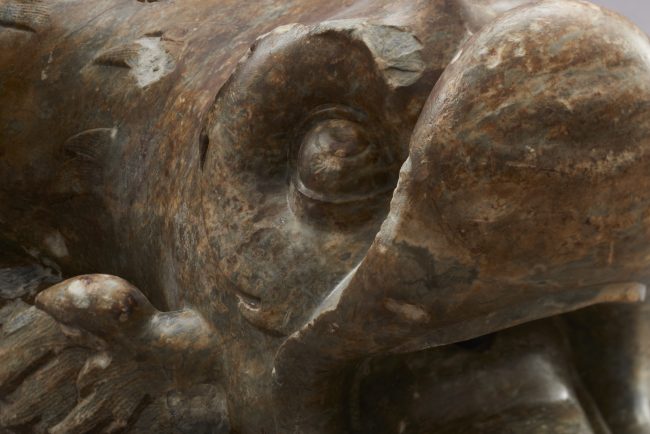
Dolphin – fragment of the garden fountain from Villa Regia (Kazimierzowski Palace)
I’ll bump into a dolphin-fish / The cruel jaw of that fish / And on it a boy stands / Poor thing, a baton in his hands
This is what Adam Jarzębski (c.1590–1649) wrote about the sculpture seen in the royal garden of Villa Regia in his Gościniec abo krótkie opisanie Warszawy (Highroad, or a Short Description of Warsaw), published in 1643. Until the present day, the composition has only preserved the dolphin and the (in all likelihood) cupid with a fragment of a baton – both belong to the collection of the Museum. The high-class dolphin sculpture was in all likelihood created by an Italian artist, in grey marble with blueish veins, probably originating from Carrara. Given its maritime connotations, the image of a dolphin provided a popular element of fountains. Already since antiquity, this mammal had a symbolic charge that related not only
to water, its rapidity and speed, but also to love and pleasure. The image of a dolphin and a cupid who attempts to hit the animal, can be understood as a reference to the struggle with lust.
Villa Regia, the private summer residence of the House of Vasa, was raised outside the city walls, on the escarpment with a view of the Vistula River. The area along the escarpment and Krakowskie Przedmieście Street bore witness to intensive development after the royal court moved from Kraków to Warsaw in 1609. On the occasion of the marriage with Archduchess Cecilia Renata of Austria (1611–1644, Queen of Poland 1637–1644), King Ladislaus IV Vasa (1595–1648, King of Poland 1632–1648) commissioned architectural alterations to the residence. In 1637, upon the King’s order, marble reliefs and figures with mythological themes were purchased in Florence. They served to adorn the palace and its garden; and the dolphin was one of them.
Less than twenty years after the alterations, during the Swedish Deluge (1655–1660; the Swedish invasion of the Polish-Lithuanian Commonwealth), the Villa was ravaged, just like the rest of the city of Warsaw. Swedish armies looted both movable objects and architectural details which were then transported down the Vistula River to the ports on the sea coast.
One such load containing stone details from Villa Regia was drowned by the Swedish after it had run aground at the level of the village of Golędzinów (currently the Praga-North district of Warsaw). In all likelihood, a signature – visible on the dolphin’s lips and head – was left by the Swedish looters and consists of numbers and names, such as Joachim Schwebs.
The first failed attempt to locate the drowned treasure was made soon after the Swedish war had come to an end. However, it was only in 1906 that Warsaw sandmen reclaimed part of the looted decorations during several days of works supervised by engineer Heliodor Nieciengiewicz (dates of birth and death unknown). Owing to the description included in Gościniec, Władysław Korotyński (1866–1924), historian and publicist who participated in the works, determined the origin of architectural details. In 2009, employees of the University of Warsaw’s Institute of Archaeology explored the bottom of the Vistula River. Their efforts made it possible to uncover six tons of artefacts until 2012, many of which originated from Villa Regia. The architectural details reclaimed in the recent years, as well as those uncovered in the early 20th century, constitute an outstanding example of the art of the Vasa period and offer a possibility to reconstruct the appearance and decorations of the royal residence.
Dolphin – fragment of the garden fountain from Villa Regia (Kazimierzowski Palace)
UNKNOWN ARTIST
ITALY (?); BEFORE 1637
GREY MARBLE
MHW 479
54 × 110 × 57 CM
Image licensed under: ![]()
